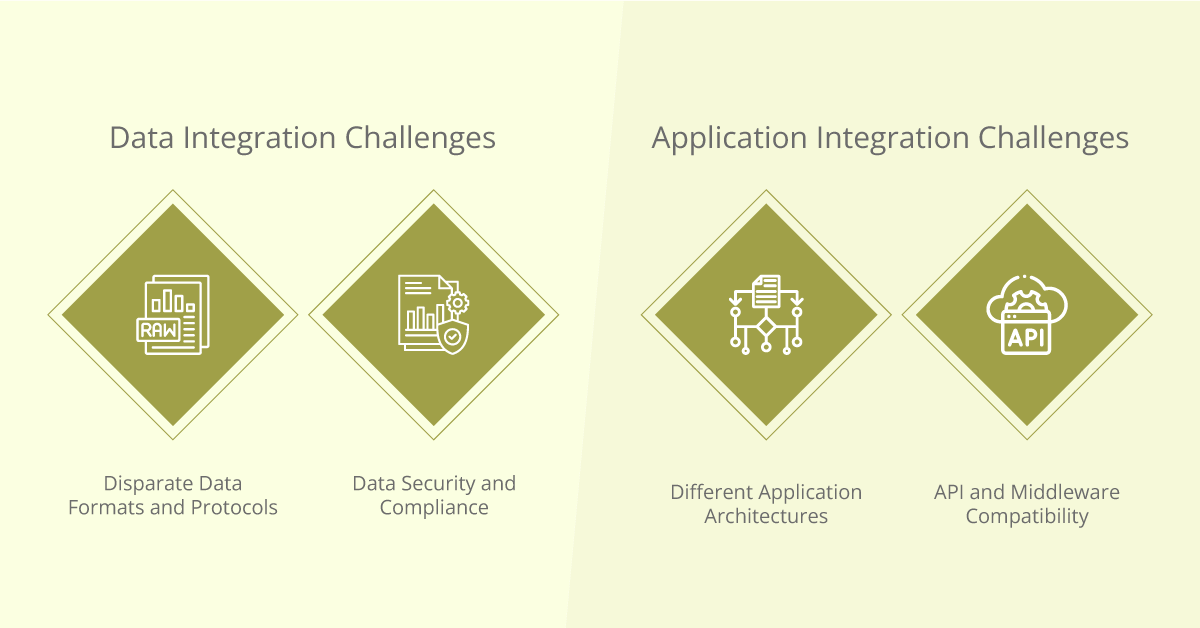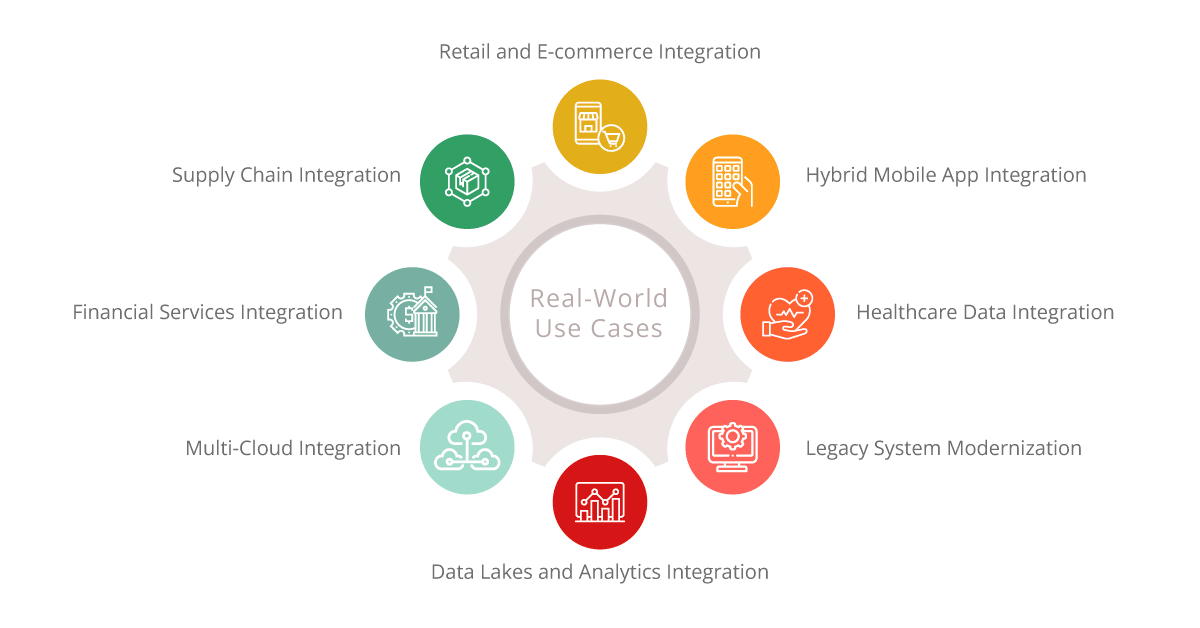Embracing the digital era, businesses are embracing the power of hybrid IT environments, combining the strengths of on-premises and cloud infrastructure. However, the integration of diverse systems and applications within this hybrid landscape brings forth its fair share of challenges. In this article, we delve into the integration hurdles encountered in a hybrid IT environment and delve into effective solutions to conquer them. By gaining a comprehensive understanding of these challenges and implementing the appropriate solutions, organizations can effortlessly facilitate data flow, streamline business processes, and unlock the true potential of their hybrid infrastructure.
As organizations venture into the hybrid IT landscape, they encounter a multitude of integration challenges. Firstly, the coexistence of legacy systems and modern applications demands a seamless connection between the two. Bridging the gap between outdated technologies and cutting-edge solutions can be a complex task that requires careful planning and execution.
Secondly, the hybrid IT environment often comprises a combination of on-premises systems and cloud-based services. The integration of these diverse platforms requires establishing secure connections, ensuring data consistency, and enabling smooth communication between on-premises and cloud environments. Achieving this level of integration can be intricate and necessitates robust solutions.
Furthermore, organizations must tackle the challenge of integrating disparate applications and services that operate on different protocols, interfaces, and data formats. Harmonizing these applications to enable efficient data exchange and workflow orchestration can be a daunting endeavor.
Data security and compliance also emerge as significant concerns in a hybrid IT environment. As data traverses through various systems and environments, ensuring its confidentiality, integrity, and compliance with regulatory standards becomes paramount. Organizations must implement rigorous security measures and adhere to industry regulations to protect sensitive data throughout the integration process.
Lastly, the complexity of managing and monitoring the integrated systems in a hybrid environment poses a significant challenge. Organizations require comprehensive visibility into the data flows, system performance, and error detection to ensure seamless operations. Efficient monitoring and management tools are essential to identify bottlenecks, troubleshoot issues, and optimize the performance of the integrated infrastructure.
Aonflow iPaaS – Free for First 3 Months!
Build and run up to 1,500 transactions monthly with no cost. No payment info needed!
Understanding Hybrid IT Environments
A hybrid IT environment is a combination of on-premises infrastructure and cloud resources, enabling businesses to utilize the strengths of both models. On-premises infrastructure refers to the physical servers, storage systems, and networking equipment hosted within an organization’s own data center. Cloud resources, on the other hand, are services and infrastructure provided by third-party cloud service providers. These can include infrastructure as a service (IaaS), platform as a service (PaaS), and software as a service (SaaS) offerings.
The integration of these components allows organizations to achieve greater scalability, flexibility, and cost efficiency. However, it also introduces integration challenges that need to be addressed for smooth and efficient operations.
Integration Challenges in a Hybrid IT Environment
Data Integration Challenges:
a. Disparate Data Formats and Protocols:
In a hybrid IT environment, different systems may use varying data formats and communication protocols, making data integration complex. For example, integrating a legacy on-premises ERP system, which uses proprietary data formats and protocols, with a cloud-based CRM platform that follows industry-standard formats and protocols can pose challenges.
b. Data Security and Compliance:
Data security and compliance become critical concerns when integrating data from on-premises systems with cloud-based applications. Organizations must ensure the protection of sensitive data and comply with regulations such as GDPR, HIPAA, or PCI-DSS. For instance, integrating customer information from on-premises databases with cloud-based analytics tools requires robust encryption and tokenization techniques to secure data during transit and storage.
Application Integration Challenges:
a. Different Application Architectures:
Applications in a hybrid IT environment may have different architectures, such as monolithic on-premises applications and microservices-based cloud applications. Integrating these diverse architectures can be challenging due to differences in deployment models, scalability, and communication patterns.
b. API and Middleware Compatibility:
Integrating applications in a hybrid environment often requires seamless communication through APIs and middleware. However, compatibility issues between on-premises systems and cloud services can hinder integration. Ensuring that APIs and middleware are compatible with both on-premises and cloud environments is crucial for successful integration.
Solutions for Integration Challenges
Data Integration Solutions:
a. Data Transformation and Mapping:
To address the challenge of disparate data formats and protocols, organizations can employ data transformation and mapping techniques. Data transformation tools, such as Extract, Transform, and Load (ETL) processes, can convert data from one format to another and map data fields between systems. For example, ETL tools can transform data from a legacy on-premises system into a format compatible with a cloud-based application.
b. Data Encryption and Tokenization:
Data security and compliance can be ensured by implementing encryption and tokenization techniques. Encryption safeguards data during transit and storage, while tokenization replaces sensitive data with non-sensitive tokens. By applying these methods, organizations can maintain data integrity and protect sensitive information when integrating systems across hybrid environments.
Application Integration Solutions:
a. Hybrid Integration Platforms:
Hybrid integration platforms provide pre-built connectors and adapters that facilitate seamless integration between on-premises and cloud applications. These platforms enable organizations to connect systems, exchange data, and synchronize business processes across the hybrid environment. By utilizing a hybrid integration platform, companies can achieve better interoperability and streamline their application integration efforts.
b. API Gateways and Service Mesh:
API gateways and service mesh architectures play a crucial role in integrating applications in a hybrid IT environment. API gateways act as intermediaries between applications, managing API calls, enforcing security policies, and providing protocol translation. Service mesh, on the other hand, focuses on communication within microservices-based applications, handling service discovery, load balancing, and traffic management. By deploying API gateways and service mesh architectures, organizations can ensure secure and efficient communication between different applications and services.
Best Practices for Successful Integration
To achieve successful integration in a hybrid IT environment, organizations should follow these best practices:
Thorough Assessment: Conduct a comprehensive assessment of integration requirements and objectives. Understand the systems involved, data flows, and business processes to identify integration points and potential challenges.
Integration Strategy and Roadmap: Create a well-defined integration strategy and roadmap that aligns with business goals. Determine the sequence of integration, prioritize critical systems, and establish a clear timeline for implementation.
Robust Monitoring and Error Handling: Implement robust monitoring mechanisms to track data flows, system performance, and error detection. Establish error handling processes and automated alerts to address issues promptly and minimize downtime.
Effective Collaboration: Foster collaboration between IT teams and business stakeholders. Involve representatives from different departments to ensure that integration efforts align with business requirements and objectives.
Aonflow is the leading integration platform.
You can kick-start by integrating your first-ever workflow in just a matter of minutes.
The Role of iPaaS in Hybrid IT Integration
As organizations strive to overcome integration challenges in a hybrid IT environment, Integration Platform as a Service (iPaaS) emerges as a valuable solution. iPaaS is a cloud-based integration platform that facilitates the connection and seamless data exchange between various systems and applications, regardless of their location or architecture. Let’s explore how iPaaS plays a crucial role in addressing the integration challenges discussed earlier.
Data Integration with iPaaS:
iPaaS company such as Aonflow offers robust capabilities for data integration by providing connectors, transformation tools, and mapping features. These functionalities enable organizations to establish connections between on-premises systems, cloud-based applications, and external data sources. iPaaS allows for real-time data synchronization, enabling organizations to access accurate and up-to-date information across their hybrid IT environment.
Application Integration with iPaaS:
iPaaS offers a range of tools and features to support application integration in a hybrid environment. It provides pre-built connectors and adaptors that facilitate the seamless integration of applications, regardless of their architecture or deployment model. iPaaS supports various integration patterns, such as point-to-point, publish-subscribe, and request-reply, enabling organizations to implement flexible and scalable application integration solutions.
Data Security and Compliance with iPaaS:
iPaaS providers prioritize data security and compliance by implementing robust security measures and adhering to industry standards. They offer encryption mechanisms, secure data transmission protocols, and user access controls to ensure the confidentiality, integrity, and availability of data during integration. iPaaS platforms also support compliance with regulatory frameworks such as GDPR, HIPAA, and PCI-DSS, enabling organizations to handle sensitive data in a compliant manner.
Monitoring and Management with iPaaS:
iPaaS solutions come equipped with monitoring and management capabilities that provide organizations with visibility into the integration processes and system performance. They offer dashboards, logs, and alerts to track data flows, identify bottlenecks, and detect errors or anomalies. With iPaaS, organizations can proactively monitor integration processes, troubleshoot issues, and optimize performance to ensure smooth operations in their hybrid IT environment.
Scalability and Flexibility with iPaaS:
iPaaS platforms are designed to handle integration requirements in dynamic and rapidly changing environments. They offer scalability and elasticity, allowing organizations to scale their integration infrastructure up or down based on demand. iPaaS enables organizations to adapt quickly to changing business needs, integrate new systems or applications, and accommodate evolving integration requirements in their hybrid IT environment.
By leveraging the capabilities of iPaaS, organizations can simplify and accelerate their integration efforts in a hybrid IT environment. iPaaS serves as a central hub that connects disparate systems, streamlines data exchange, ensures data security and compliance, and provides monitoring and management capabilities. It enables organizations to achieve seamless connectivity, optimize business processes, and unlock the full potential of their hybrid infrastructure.
Real-World Use Cases
To provide practical insights into the integration challenges and solutions in a hybrid IT environment, let’s explore some real-world use cases:
Use Case: Retail and E-commerce Integration
In the retail sector, integrating an on-premises inventory management system with a cloud-based e-commerce platform is crucial for efficient order management, inventory synchronization, and seamless customer experiences.
Solution: Utilizing an integration platform as a service (iPaaS) can bridge the gap between the systems. By connecting the on-premises inventory management system and the e-commerce platform, iPaaS enables real-time synchronization of product information, updates inventory levels, and facilitates seamless order processing and fulfillment.
Use Case: Healthcare Data Integration
The healthcare industry often deals with multiple systems, such as electronic health records (EHR), clinical systems, and billing platforms. Integrating these systems is vital to provide comprehensive patient care and enable effective healthcare management.
Solution: Implementing a data integration solution that leverages healthcare interoperability standards like HL7 (Health Level Seven) and FHIR (Fast Healthcare Interoperability Resources) can facilitate secure and standardized data exchange between systems. This enables healthcare providers to access and share patient data seamlessly, support analytics initiatives, and enhance population health management.
Use Case: Financial Services Integration
Financial institutions need to integrate various systems, such as core banking applications, customer relationship management (CRM) systems, and payment gateways, to deliver seamless financial services and personalized customer experiences.
Solution: An API-first approach can simplify integration efforts in the financial sector. By developing and exposing APIs, organizations can establish a standardized and secure communication channel between systems. This allows customers to access their account information, initiate transactions, and leverage financial services seamlessly across multiple channels, ensuring a unified and consistent experience.
Use Case: Supply Chain Integration
Challenge: A company operates a complex supply chain network with multiple systems, including suppliers, manufacturers, distributors, and retailers. They face the challenge of integrating these disparate systems to enable real-time visibility into inventory, streamline order processing, and optimize supply chain operations.
Solution: By leveraging iPaaS, the company can connect and integrate its supply chain systems, including enterprise resource planning (ERP) systems, warehouse management systems (WMS), and order management systems (OMS). iPaaS enables seamless data exchange and synchronization, ensuring accurate inventory management, efficient order fulfillment, and enhanced supply chain visibility.
Use Case: Multi-Cloud Integration
Challenge: An organization utilizes multiple cloud platforms, such as Amazon Web Services (AWS), Microsoft Azure, and Google Cloud Platform (GCP), to leverage different services and capabilities. They face the challenge of integrating data and processes across these disparate cloud environments to enable unified operations and data management.
Solution: iPaaS provides connectors and adaptors for various cloud platforms, allowing organizations to integrate data and processes across different cloud environments. With iPaaS, they can establish seamless data flows, synchronize data, and orchestrate workflows across multiple clouds. This enables organizations to leverage the strengths of different cloud platforms while maintaining a cohesive and integrated IT environment.
Use Case: Hybrid Mobile App Integration
Challenge: A company develops a hybrid mobile app that combines native and web-based components. They need to integrate the app with backend systems, such as customer databases, payment gateways, and content management systems (CMS), to provide a seamless and personalized user experience.
Solution: iPaaS enables the integration of hybrid mobile apps with backend systems by providing standardized APIs and connectors. With iPaaS, organizations can establish secure connections between the mobile app and backend systems, enabling real-time data exchange and seamless functionality. This allows for personalized user experiences, secure payment processing, and dynamic content delivery.
Use Case: Legacy System Modernization
Challenge: An organization has legacy systems running on outdated technologies that hinder innovation and agility. They face the challenge of modernizing these systems and integrating them with new cloud-based applications to improve efficiency and unlock new capabilities.
Solution: iPaaS serves as a bridge between legacy systems and modern applications by enabling seamless integration. Organizations can leverage iPaaS to connect legacy systems with cloud-based applications and services, allowing for data synchronization, business process automation, and seamless communication. This enables organizations to modernize their systems incrementally while maintaining critical functionality and data continuity.
Use Case: Data Lakes and Analytics Integration
Challenge: A company wants to leverage a data lake architecture to consolidate and analyze large volumes of data from diverse sources. They face the challenge of integrating data from various on-premises systems, cloud applications, and external data sources into the data lake for comprehensive analytics.
Solution: iPaaS facilitates the integration of data lakes by providing connectors, data transformation capabilities, and data ingestion mechanisms. Organizations can use iPaaS to connect and integrate data from multiple sources, cleanse and transform the data, and load it into the data lake for analysis. This enables organizations to derive valuable insights from a unified and comprehensive dataset, driving data-driven decision-making and business intelligence.
Final Thoughts
Integrating systems and applications in a hybrid IT environment can be complex, but with the right understanding and solutions, organizations can overcome these challenges and unlock the full potential of their hybrid infrastructure. By leveraging data integration and application integration solutions, adopting best practices, and learning from real-world use cases, businesses can achieve seamless connectivity, optimize processes, and drive innovation in their hybrid IT environments. Embracing integration in the hybrid era is crucial for organizations aiming to thrive in the digital age.
Integration Platform as a Service (iPaaS) emerges as a powerful solution for addressing the integration challenges in a hybrid IT environment. With its data integration, application integration, data security, monitoring, and scalability capabilities, iPaaS enables organizations to overcome complexities and achieve seamless integration across their hybrid infrastructure. By harnessing the power of iPaaS, organizations can unlock new opportunities, enhance operational efficiency, and drive innovation in the hybrid IT landscape.
Aonflow iPaaS – Free for First 3 Months!
Build and run up to 1,500 transactions monthly with no cost. No payment info needed!


